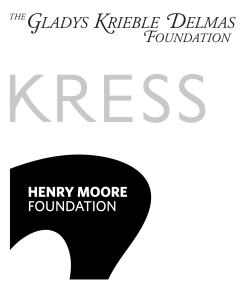The Hood Museum of Art will present Living with Sculpture: Presence and Power in Europe, 1400–1750 from March 23, 2024, through March 22, 2025.
February 19, 2024—Hanover, N.H.— The Hood Museum of Art will present Living with Sculpture: Presence and Power in Europe, 1400–1750 from March 23, 2024, through March 22, 2025. Drawing on the wealth of the Hood Museum's permanent collection, this exhibition contributes to the field's understanding of the role of sculpture in everyday life, historically and today. Whether given as tokens of affection, cast to memorialize important events, designed to promote faith, or used to write a letter, these sculptures engaged their spectators in dialogues of devotion, authority, and intimacy.
Living with Sculpture is curated by two scholars at the Hood Museum of Art: Elizabeth Rice Mattison, Andrew W. Mellon Curator of Academic Programming and Curator of European Art, and Ashley B. Offill, Curator of Collections. It includes 164 objects in two galleries and is accompanied by a major publication of the same title now available for pre-order.
Sculpture enlivened private and public spaces in medieval and Renaissance Europe, contributing to presentations of identity, practices of devotion, and promotions of nationhood. Featuring objects made across the continent, this exhibition examines the significance of sculpture between 1400 and 1750, an era of profound cultural and social change. Amid war, colonization, religious conflict, academic upheaval, and social stratification, these works of art ornamented homes, altars, libraries, and collections.
The role of sculpture as a commemorative and connective tool is newly evident in today's debates about monuments and cultural patrimony. Sculpture manipulates notions of history, forges bonds between distant places, and promotes future actions, as this exhibition shows.
Bringing this often-cerebral area of study down to earth, exhibition curators Elizabeth Rice Mattison and Ashley B. Offill note, "In examining a group of historic objects, this exhibition highlights the way that the material things with which we surround ourselves are critical to developing our personal identities and our relationships with one another. As curators, we lived with these objects during this project, gaining insight into the works and the people who owned them. The choice of a laurel wreath or a cross on a medal was, in many ways, just as informative back then as a social media bio is today."
Recent examinations of sculpture suggest its singular presence and power for its makers, patrons, and audiences. The dynamism of sculpture became particularly evident in the 15th and 16th centuries with the explosion of interest in purchasing mass-produced objects such as plaquettes and small-scale bronzes. Technological innovations in making sculpture allowed artists to expand their markets and create new types of artwork.
Organized thematically, this exhibition focuses on small-scale sculptures for everyday spaces. With these works, artists could enhance their status and promote their creativity. Meanwhile, useful sculptures like locks and inkwells communicated their owners' identities and prestige. In collecting sculptures, patrons activated their social connections. Sculpture also facilitated access to the divine, through objects that focused prayer and encouraged tactile connection with God. Similarly, sculptures forged a sense of history, recording contemporary events and promoting ideas about the past. Together, the sculptures presented here attest to how objects in bronze, wood, or stone gave meaning to people's lives in early modern Europe.
This exhibition and its corresponding catalogue are organized by the Hood Museum of Art, Dartmouth, and generously supported by the Leon C. 1927, Charles L. 1955, and Andrew J. 1984 Greenebaum Fund, and by grants from the Gladys Krieble Delmas Foundation and the Samuel H. Kress Foundation.
gilded_sponsor_logos_for_website.jpg


